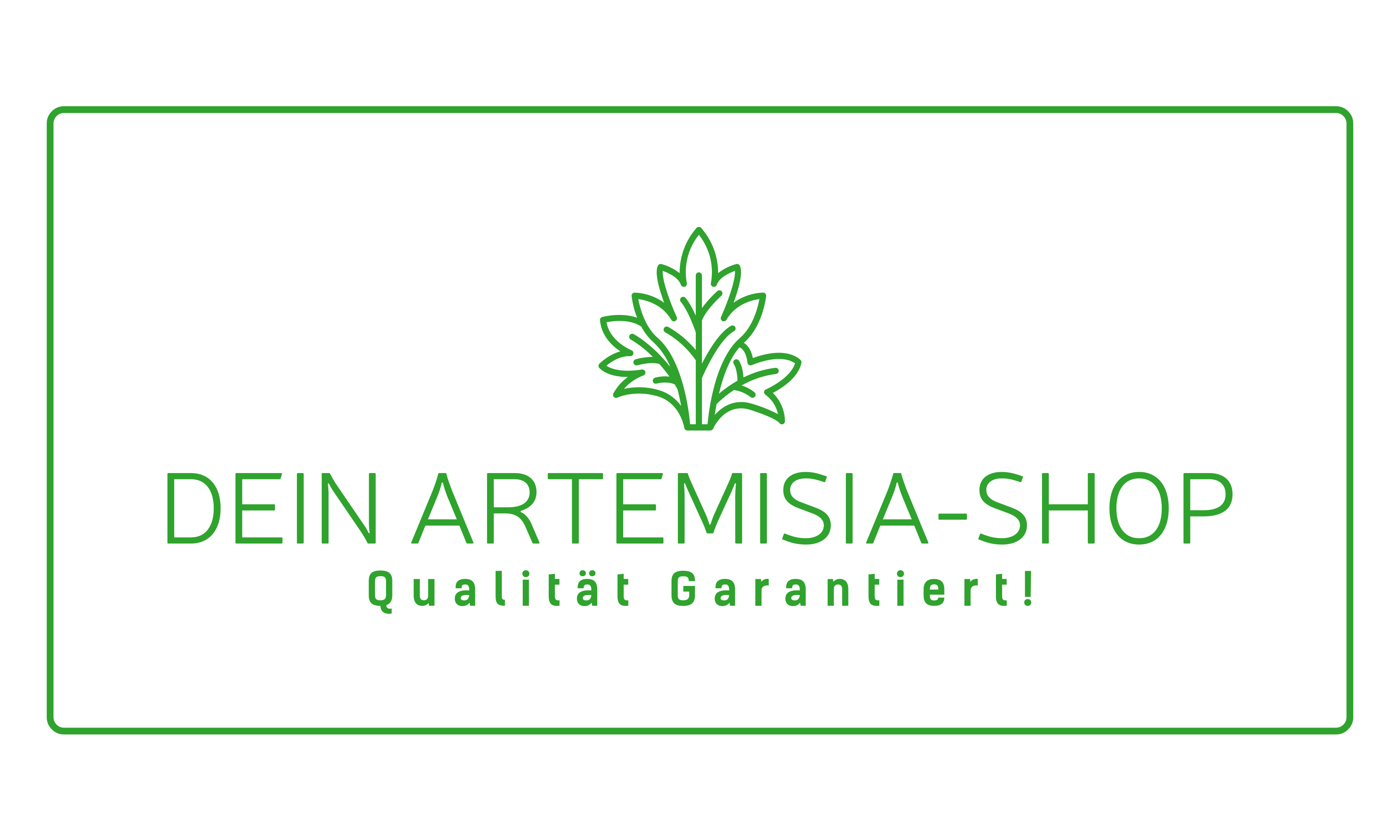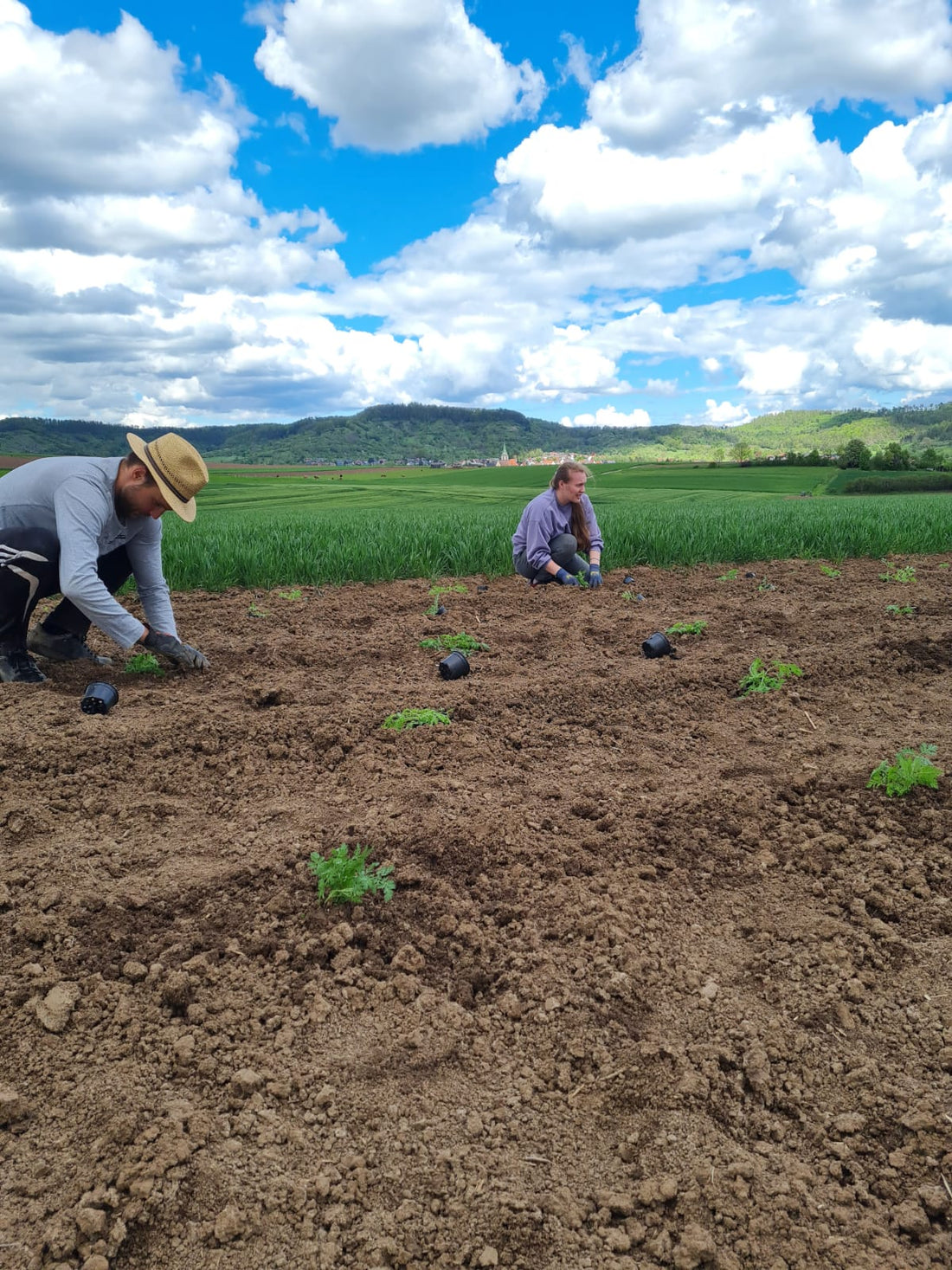Artemisia annua, or annual mugwort, known as a medicinal plant in Chinese medicine, belongs to the composite family and is only one of up to 400 species of the genus mugwort (Artemisia). The annual mugwort has been used for thousands of years, especially in Asia. The plant (Artemisia annua) should not be confused with the perennial mugwort (Artemisia vulgaris), a plant that is also common in Germany. The annual mugwort is one of the plants that can be used in many ways due to its effect, which is why it is now enjoying increasing interest.
No wonder! After all, it was only in 2015 that the Nobel Prize for Medicine was awarded to Ms Youyou Tu for the discovery of the active ingredient artemisinin of the Artemisia plant. She succeeded in isolating the plant substance artemisinin, which is used to treat malaria, from the annual mugwort. The artemisinin of the mugwort Artemisia annua is mainly found in the leaves. This is contained in a particularly high concentration in the plant shortly before flowering.
Our farm (Your Artemisia-shop) has been cultivating the annual mugwort (Artemisia annua) for several years. In order to be able to guarantee a high-quality product from the Artemisia annua plant, our mugwort goes through an elaborate cultivation, harvesting, drying and further processing process. This process is carried out from start to finish exclusively by our trained team. It is important to us to promote sustainability and ecological processes in the production of our products and to emphasise regional cultivation. Every year we cultivate our "most fertile" fields with the annual mugwort (Artemisia annua) in order to guarantee a harvest-fresh top quality. Several quality controls and carefully designed processes ensure the quality of our products.
In this blog entry we want to take you through the cultivation, harvesting, drying and further processing of this valuable Artemisia annua medicinal plant, from sowing to the end product.
Planting Artemisia annua: location and procedure
Where should Artemisia annua be sown?
As already mentioned, Artemisia annua has its origins in Asia. There, the annual mugwort has been used in Chinese medicine for over 2000 years. In recent years, however, it has also been used more and more in Central and Southern Europe. This is partly due to the fact that Artemisia annua can be grown in most climatic zones. Thus, under certain circumstances, the plant can also be planted in Germany. Permeable, calcareous and nutrient-rich soils, as well as plenty of sun and light, are helpful for this. Only the sensitivity of annual mugwort to frost makes cultivation in Central European regions somewhat more complicated. Artemisia annua belongs to the so-called "light germinators". The seeds are therefore not covered with the sowing soil, but only lightly pressed and covered with a light layer of soil so that the seeds get enough light.
When should Artemisia annua be sown?
Our Artemisia annua seeds are sown at the end of February. The Artemisia seeds are particularly striking because of their small size. 12,000 seeds weigh only one gram! To protect the seeds from frost and cold after sowing, they are grown under room temperature. Under the right temperatures, the seeds germinate after about 7-14 days.
When to prick out Artemisia annua?
After the Artemisia annua seedlings have germinated and grown about 10 cm, they are pricked out. This process is very time-consuming, but extremely important so that the plants do not compete with each other for the limited supply of nutrients and have room to develop. When pricking out, each Artemisia annua plant gets its own little pot. The necessary "know-how" is important here so that the small plants are not damaged during this process.
How is Artemisia annua cared for?
Annual mugwort does not tolerate frost and is therefore grown in the warm during the cold months. It remains there until frost is no longer expected. Regular watering and plenty of light are essential during these months to promote vigorous growth. Too much shade can dilute the colours of the plant or lead to stunted growth. Artemisia annua plants are stress bloomers. So it is extremely important not to let the plant dry out, nor to deny it enough light. Annual mugwort is rarely affected by diseases. This is because the Artemisia annua plant is particularly resistant. The bitter substances contained in the leaves ensure that numerous pests and pathogens are kept out and the plant is not attacked by parasites. In addition, the leaves emit an intense aromatic smell that also keeps sap-sucking insects away.
 @Ton Rulkens https://flic.kr/p/8dFRVU
@Ton Rulkens https://flic.kr/p/8dFRVU
When should Artemisia annua be planted?
At the end of May, each plant is planted in our well-prepared and weed-free fields. The plants grow up to 2 metres high in good weather conditions. The harvest of our mugwort usually takes place in August. Until then, the plants continue to need plenty of water and light until a large root system has formed. If there is little rain, the mugwort must be supplied with water partly by hand. Drought stress must be avoided at all costs so that an optimal growth process of the plant can take place. Weeds are removed from the fields by regular tilling and hoeing. Only in this way can we guarantee that our Artemisia products are weed-free and qualitatively clean.
A prerequisite for good growth is nutrient-rich soil and the right plant spacing. If the soil is poor in nutrients and the roots are given too little space to develop, the plant will become much smaller. To be able to plant the plant optimally, the soil must be worked and properly loosened beforehand. Our experience in agriculture helps us to prepare the soil optimally. Once the plant has been planted, we have to keep an eye on the fields. It is important to hoe not only mechanically, but also by hand, as stubborn weeds often sprout up on the plant after just a few days.

Harvest Artemisia annua:
When is Artemisia annua harvested?
The annual mugwort can be harvested in August, September and October. During this period, the plants reach a height of about 130cm to 200cm. Its leaves are now about 3 to 5 cm long and shine in lush green. This is the right time to harvest our medicinal herbs. The plants emit a fragrant, long-lasting, aromatic scent. This can have a very pleasant and relaxing effect on the human organism. To ensure that our elaborate harvest of Artemisia annua plants is successful, we receive active support year after year from our families, friends and regional harvest helpers. Should the first frost be delayed, the annual mugwort can also be harvested beyond October. However, our experience shows that the plants show the first signs of weakness by mid-November at the latest and dry out quickly, especially in excessively cold weather. If this is the case, the plants are chopped down at the end of the harvest. Further processing of the plant by removing seeds is not recommended, as the seeds can only produce a weakened form of the active substances. Annual mugwort is grown from hybrid seeds, i.e. seeds obtained from crosses. This means that the parent plants are cross-pollinated with themselves over several generations until the specifically desired properties of the medicinal plant are worked out. The parent line is bred for perfection.
How is Artemisia annua harvested?
The annual mugwort should only be harvested by hand. The reason for this are brown/yellow nutrient-poor leaves that form inside the plant. These are strictly sorted out during our harvest so that only the juicy and nutrient-rich leaves are harvested. The precision and care required to ensure the best quality of the products cannot be achieved with mechanical harvesting. When an Artemisia annua plant comes into flower, it is no longer harvested and uprooted in order to protect allergy sufferers in the final product. It is an advantage that our special cultivation, which is up to 20 times more effective than the wild form, rarely produces flowers. If, however, a flower does occasionally appear, this is considered a criterion for excluding the plant from the further harvesting process.

Processing Artemisia annua:
How is Artemisia annua dried?
After each harvest day, the freshly harvested leaves are taken to our drying facilities. These have been specially made and optimised for Artemisia drying. There, the leaves are dried gently and at an optimal temperature over the following days. It is important that the leaves are neither too moist nor too dry. Once they have reached an optimal degree of moisture, the leaves and their stems are separated using a sieving machine. The sieving machine is also specially developed for processing our Artemisia plants. In the end, only the green Artemisia leaves remain, which have a high nutrient content. From a 2-metre high plant, only little usable material remains for the high-quality end product, which does not always benefit, for example, a small-scale private cultivation on the balcony or in the garden.
How is Artemisia annua stored?
The dried Artemisia annua leaves are immediately packed airtight to ensure maximum shelf life for our customers. It is important that dried Artemisia annua does not come into contact with extreme cold or extreme humidity.
Is Artemisia annua hardy?
As it is an annual mugwort, every single plant is cut down at the end of the harvest. The reason for this is that Artemisia annua plants do not tolerate frost and therefore have to be replanted year after year. This closes the cycle, which starts again with sowing the next year.
Important: We do not use any pesticides. This is also confirmed by our laboratory results at the BAV Institute.
Buy Artemisia-annua in the shop
You would like to buy and try our home-grown organic Artemisia annua now?
Then secure it now and click on the button "Products" in the upper bar!
If you have any questions about our products, our managing director Lucas Genkinger will be happy to help. You can find his e-mail address under Contact or here: lgenkinger@artemisia-shop.de (e-mail address).
We wish you all the best,
Your Artemisia-Shop Team

